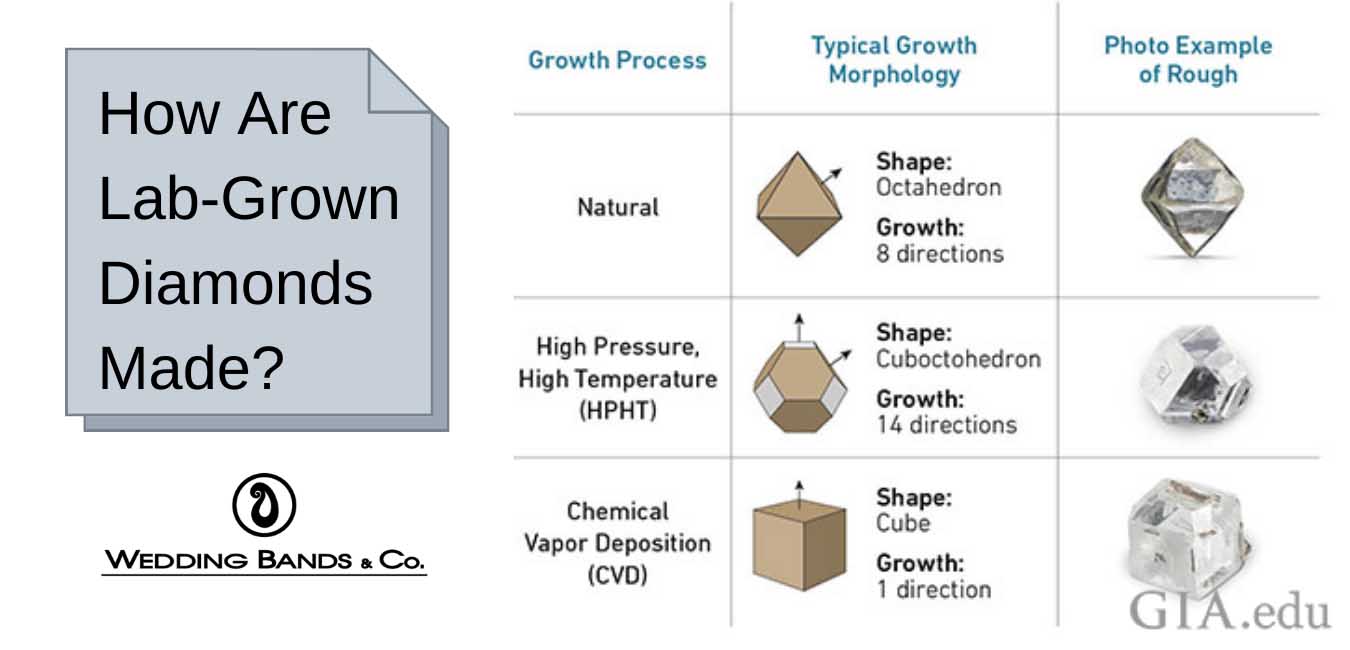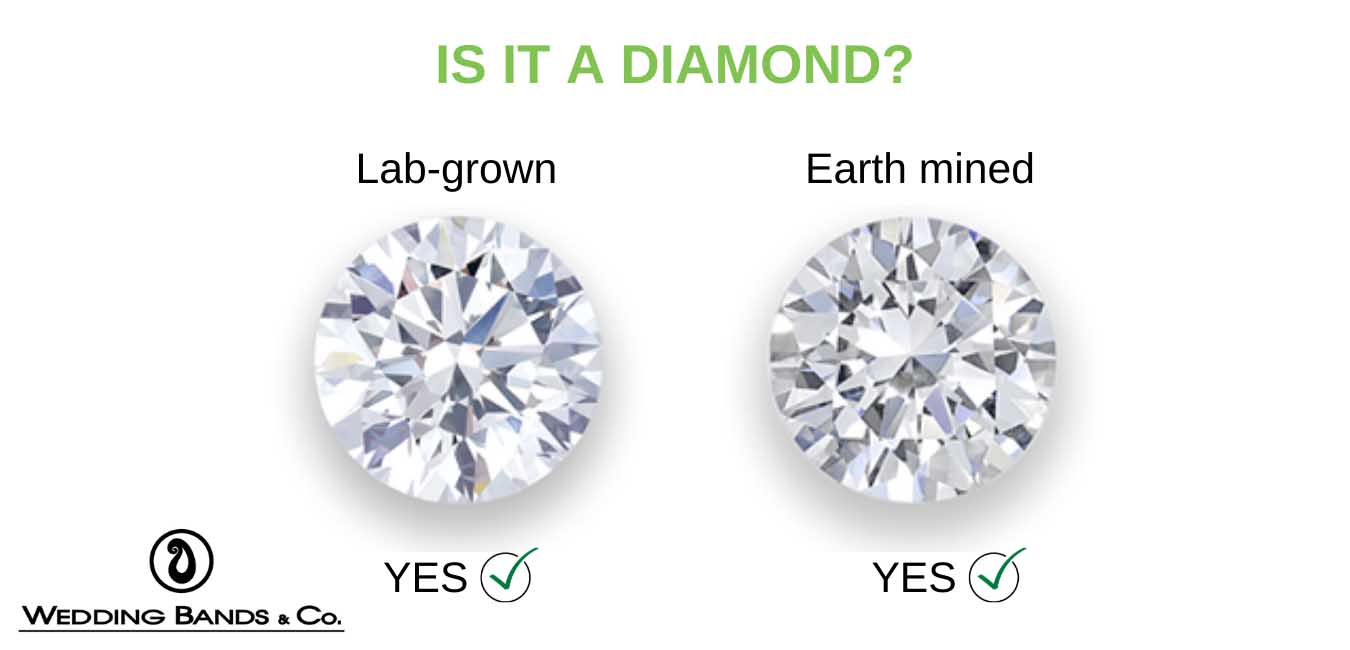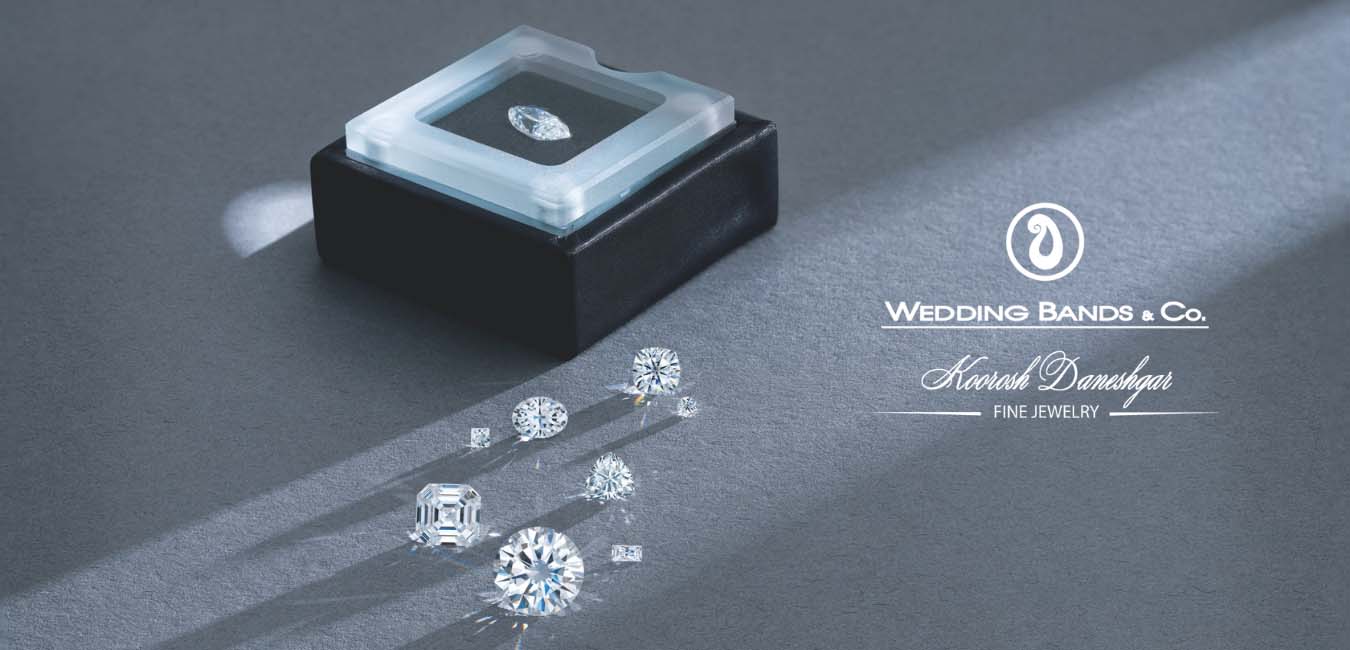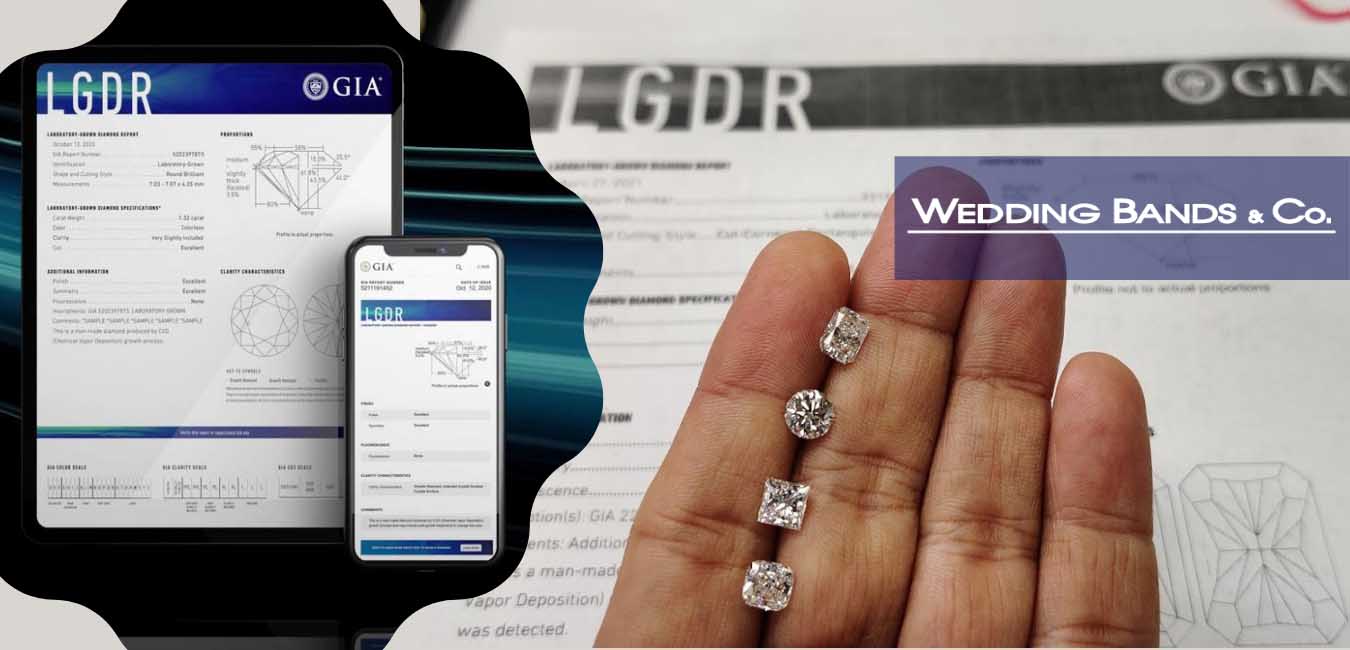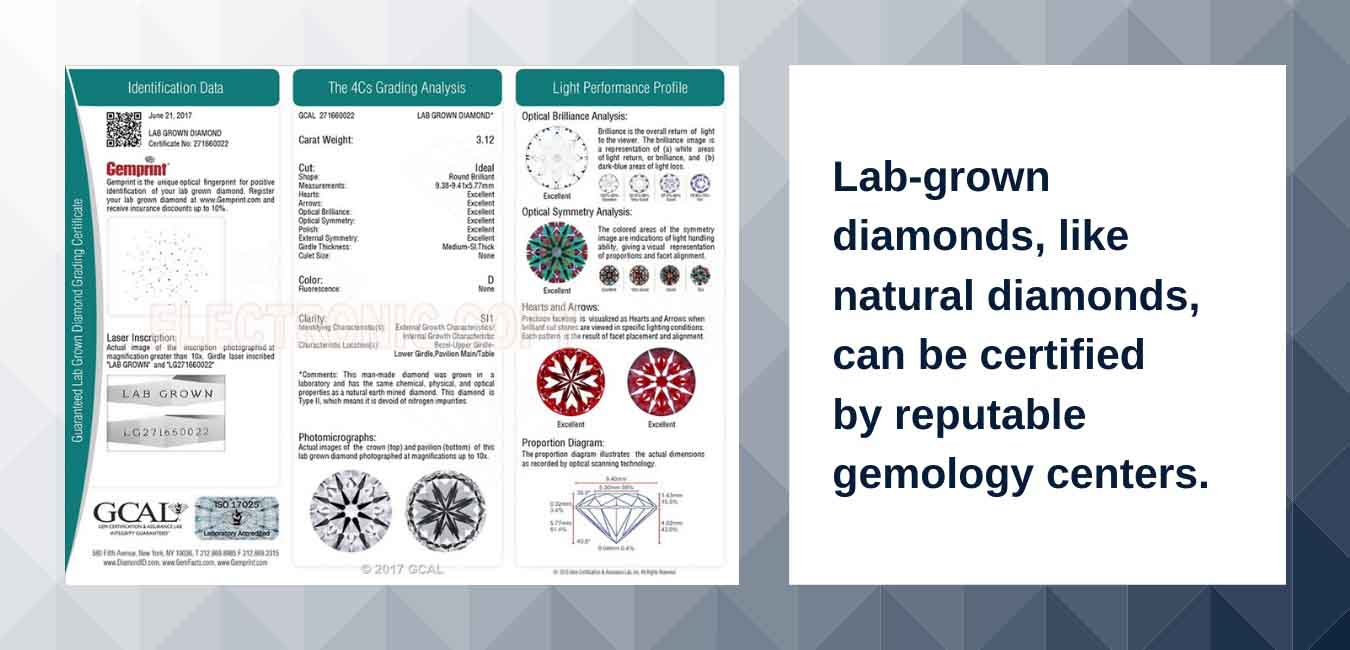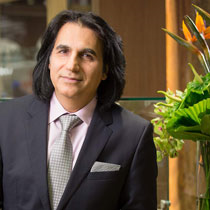Lab Grown Diamonds Price & Value
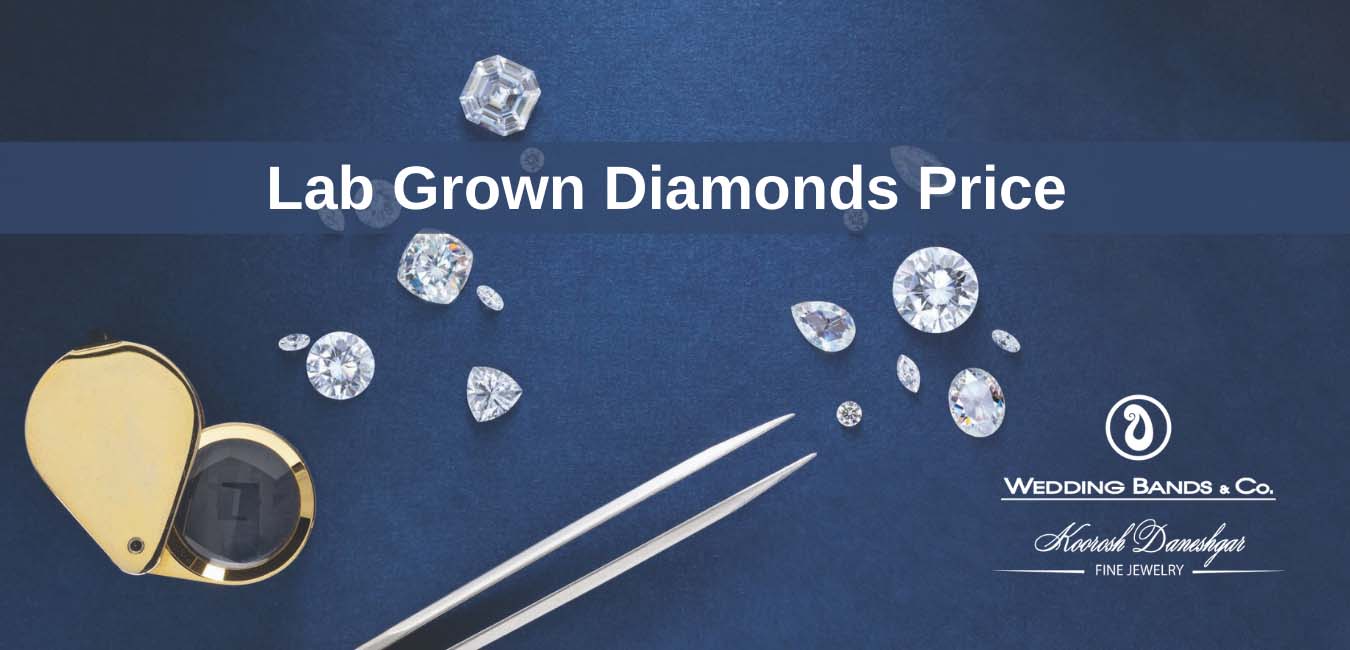
The significantly lower lab-grown diamonds price makes people consider it as a better option. One of the main dilemmas my clients face when they come to the store is whether to choose a lab-grown diamond or not. In this post, I will talk about the lab-grown diamonds price in Chicago for those who are bound to their budget.
Lab-grown
diamonds Price
There are many factors involved in pricing lab-grown diamonds
compared to natural ones, such as clarity, color, and carat weight.
Depending on any or all of the criteria mentioned, a lab-grown diamond can cost more than 20% less than its natural mined counterpart. In case of rare color, a
3-carat mined diamond costs 3 times more than a lab-grown.
Considering your
budget, you may decide to purchase a lab-grown diamond rather than a natural
one. However, this choice encompasses many facets, including lab-grown diamonds price, for which you need the information below.
What is a lab-grown diamond?
Lab-grown diamonds, also known as curated diamonds, lab created diamonds, and cultured diamond, are real diamonds, which are produced in laboratories or factories instead of the earth. These diamonds are identical to mined diamonds as they are also made from carbon and have the same atomical structure. The advancement of technology has made it possible for specialists to create diamonds that are chemically and physically identical to natural diamonds, and look visually identical. They encompass both colorless and fancy color diamonds. If you want to know more about What
a Lab grown diamond is
, check this blog.
How are lab-grown diamonds made?
There are two main production methods for lab diamonds: High Pressure/High Temperature (HPHT) and Chemical Vapor Deposition (CVD).
The High Pressure-High Temperature method, is almost the same way diamonds are grown in the ground. In this process a diamond seed along with carbon in a special microwave room which can provide intense heat and pressure. After few weeks, the diamond seeds will grow into diamonds. At this point, the diamonds are cut, ground, and measured for jewelry using a laser. Since this process requires a lot of energy, HPHT is not used as much as CVD.
The beginning of CVD process is the same as HPHT where they put a diamond seed along with carbon on a tungsten disk. At this stage, these seeds are placed in a room filled with hydrogen and methane gas. The chamber will then heated up to extreme temperatures, which excites the gases and causes the diamond to grow upward on the seed crystal. After almost two weeks diamond is ready to be cut, measured and grind. As previously mentioned, this process is less expensive than HPHT and the resulting diamonds are of the same high quality as mined diamonds.
Lab-created diamonds used to be utilized only for industrial purposes at first, but the advancement resulted in its current use, which is jewelry. Nowadays, the process is so accurate and identical with the natural one that makes it impossible for even the jewelers to find out whether it is a lab diamond or its mineral counterpart.
Are lab-grown diamonds real diamonds?
Yes! The lab-grown diamonds are real diamonds. The lab-grown diamonds are quite similar to real diamonds in all of their features such as appearance, quality, color, hardness, material, and beauty. As I mentioned above, the process of making a lab-made diamond is carried out by carbon atoms at high pressure and temperature. However, the carbon atoms, high pressure, and high temperature are necessary factors to produce the natural and real diamonds under the earth’s surface.
The conditions for forming natural diamonds are similar to those for lab-grown diamonds. The main difference is the location and timing of the process. Natural diamonds formed hundreds of miles beneath the Earth’s surface, under high pressure and high temperatures, between 1 to 3 billion years ago, and reached the upper layers of the earth’s surface through volcanic explosions. While the lab-made diamonds form during a few weeks in laboratories and by human control.
What is the
value of a lab-created diamond?
The value of a
lab-created diamond falls into three categories: social, emotional, and
financial. Financially speaking, lab grown diamonds price depends on
their carat weight. For instance, a 2-carat lab diamond costs between $8,000
and $12,000 while a 4-carat D-VVS1 lab diamond costs around $95,000.
The other side of the
coin, however, is the value of lab diamonds compared to natural diamonds. In
that case, there is a huge price difference between a lab grown diamond of particular
clarity and its natural counterpart. In other words, the two lab diamonds with
identical weights, but different colors have almost the same price whereas
natural diamonds’ value varies depending on their clarity and color.
Lab diamonds have social
and environmental value for so many. Thinking about the fact that extracting
gems from the ground is harmful to Mother Nature seems true, and that causes
people to conclude lab-created diamonds more environmentally friendly than the
naturals. Another social value is that working deep in the mines may put the
health of workers in danger, and it is inappropriate to force the labor.
If your partner is an
eco-friendly person and worries about the environment, then the social value of
the gem is more important to her than its price value. Therefore, you can
reconsider choosing a diamond and buy an engagement ring with other stones or
even without any stone. To decide is out of the scope of this blog post, so you
can read further using the link below:
Is it important for girls to
have a diamond engagement ring?
Are
lab-grown diamonds cheaper?
Lab-grown diamonds are cheaper than natural mined
diamonds. Lab-grown diamonds price is dependent on several factors in
comparison to the natural price, such as carat weight, clarity, and color. The
price difference between the two is enormous in high carat weights, rare
colors, and high clarity.
The carat weight causes a significant price
difference between earth created diamonds and lab-created diamonds. In other
words, a high-carat lab-created diamond is way less expensive than a naturally
mined diamond of the same carat. The chart below displays how carat weight
affects the price gap between two E-VS1 excellent cut round brilliant diamonds:

Briefly speaking, the price difference between the
two lab-created diamonds, ranging from one to three carats, is around $18,000
while the same carat range for earth created diamonds differentiates $54,000 in
price.
Color and clarity are also important factors that
cause lab-created diamonds to cost cheaper. To say that more accurately, it
costs the same for specialists to grow each of the D, J, and I colors in a
laboratory. Therefore, the significant price difference between the two natural
diamonds of the same carat weight does not exist in lab-grown diamonds. The
chart below contains these diamond characteristics: ideal cut, round shape, and
1 to 1.60 carats:

The small portion of the carat weight range helps us
understand the price difference between the two diamonds of the same color and
clarity. The price difference between two lab-created diamonds, varying in
color (J and D) and clarity (SI2 and VS1), is $4,000. On the other hand, the
same qualities result in $21,000 between the highest and lowest prices of the
earth created diamonds.
Do lab-created diamonds hold their value?
For the past several
years, it is believed that lab grown diamonds do not have resale value and
would make a poor investment. That is true to some extent because with no doubt
mined diamonds have greater value and so they are much more expensive. Mined diamonds
have their value over time and their value will even grow year by year.
But this does not necessarily
mean that lab grown diamonds worth nothing at resale. Studies show that around
70% of customers would purchase a lab grown diamond. Therefore, with this
information at hand we can conclude that there is a market for lab grown
diamonds in the next several years. Decades from now, the value of lab grown
diamonds can also grow. According to a report by the BBC, the market for lab
grown diamonds has seen annual growth by around 15%-20%. We can conclude that
the market and demand for lab grown diamonds could change in the future.
Can you
insure lab-created diamonds?
You can both insure and appraise lab-created
diamonds. Since lab diamonds are real diamonds for which you pay thousands of
dollars, you need to make sure of their safety. There are two insurance options
you can decide, the same as natural diamond insurance, jewelry insurance and
self-insure.
Unpredictable and predictable accidents harm us
sentimentally and financially, such as a diamond engagement ring loss. Your
diamond ring might be stolen, damaged, or lost, so you need to foresee the
incident before you face the panic. A lab-grown diamond, like earth created
diamond, is potential for a tragic scenario. As the owner of this business, I
have come across so many of these tragedies, and I advise you greatly not to
postpone insuring your sentimental investment of a lab-grown diamond ring.
Self-insure: You can easily save the exact amount of money you
have spent for your diamond for critical damage in one of these two ways. If
you have the same money around, do not waste it for something else and put it
into a Certificate of Deposit. If you do not have that money for the present
moment, you can save a small portion of your salary, something like $300 every
year. However, you have to be cautioned not to touch the money out of
temptation.
Jewelry insurance: You can get the coverage by undergoing an annual
premium of 1% to 2% of the total price of your lab-grown diamond engagement
ring. The policy solutions include agreed value, actual cash value, and
replacement value.
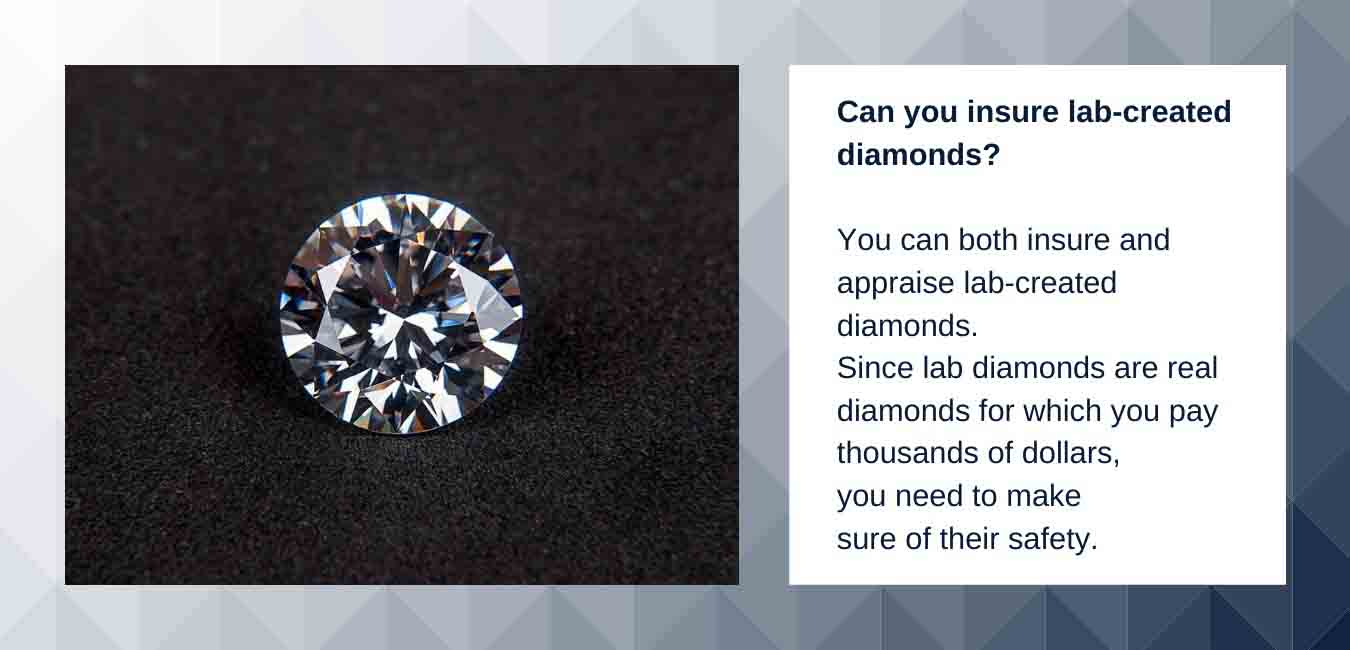
Can lab-grown
diamonds be certified?
Lab-grown diamonds weighing more than half a carat
are certifiable. The responsible laboratories, which certify your lab created
diamond ring, include the Gemological Institute of America, Gem Certification
& Assurance Lab, International Gemological Institute, and European
Gemological Laboratory.
We highly encourage you to certify your lab-grown
diamond ring just as we recommend other clients who purchase natural diamond
rings. Not only do laboratories, which are GIA, GCAL, IGI, and EGL, include the
information related to the 4-C of your diamond, but they also mention in your
certificate that the diamond is manmade.
In other words, the laboratory states in your lab
diamond’s certification the carat weight, color, clarity, cut, and the method
of growing, whether it is grown by the High Pressure-High Temperature method or
Chemical Vapor Deposition.
Since a certificate is like a document proving the
price value of your diamond ring, it is very important which certificate to choose.
However, you cannot sell your lab-grown diamond engagement ring, for it does
not have resale value. Hence, you need the certification in case your diamond
ring gets lost and you want the insurance money to pay for a replacement. Any
of the laboratories mentioned qualify to appraise your lab-grown diamond
engagement ring, for they provide useful information regarding color, carat
weight, and clarity.
The price gap between two lab-grown diamonds
differing in colors and clarity is not much unlike natural diamonds. In
addition to that, the possibility of price decline in lab diamonds is high, and
your diamond’s value might be less in the future, so you do not need to be
strict about appraising your lab diamond with popular certification.
Which
diamond lab certification is best?
GIA and AGS are popular for their consistent and
strict standard, which make them the best and most reliable diamond lab
certifications. The best diamond lab certification provides accurate
information regarding the color range, cut quality, carat weight, and clarity
grade, which determines the true price value of your diamond.
Both the Gemological Institute of America and the
American Gem Society have maintained a good reputation as the best and most
accurate certifications. Since each laboratory has its own standards for color
and clarity, we cannot object if any of the laboratories estimate one grade of
clarity and color different from the other.
Color and clarity are subjective, yet if a laboratory
estimates inconsistent grades multiple times, it lacks validity. On the
contrary, the cut quality is a very critical aspect in which both GIA and AGS
are professional and super strict.
For that reason, they are the most reliable sources
of determining whether a diamond possesses an ideal cut or not. The same is
true about the carat weight, which plays a significant role in the priced value
determination of your diamond. If you are not completely familiar with the look
and content of diamond certifications, the link below is going to work for you:
What is an Independent Diamond
Certificate?
If you have made up your mind to choose a lab diamond
for your engagement ring, other laboratories are worth consideration.
Lab-grown
diamond engagement ring
Lab-grown diamond engagement rings are real diamond
engagement rings with the only difference of possessing a manmade diamond
rather than an earth made. Having the same physical sturdiness, optical
sparkle, and chemical combination, lab-grown diamond engagement rings can be
good options for proposing marriage.
There are several reasons why someone chooses a
lab-grown diamond engagement ring:
- Since
working deep in the mines is risky for the workers’ health, some people choose
a lab-grown diamond engagement ring due to its social conscience aspect
Extracting
mined diamonds is equivalent to ripping something off nature, for which some
people feel environmentally responsible
Lab-grown
diamond engagement rings are much less expensive than natural diamonds.
Therefore, with a limited budget, you can buy a larger lab-grown diamond
Some
people do not care about the possible decline in the price value of their
lab-grown diamond engagement ring, so they prefer it over mined diamonds
Lab-grown
diamond engagement rings have the same features as their natural counterparts.
They may even produce a better light reflection
People
can get the color they desire, even the hardly findable fancy colors in nature,
with less price gap compared to natural diamonds
There are several reasons why someone chooses a
natural diamond engagement ring:
- Some
people look at a diamond engagement ring as an investment, so they prefer to
purchase a mined diamond to make sure of the value
Some
people are not fan of industrial productions. For that reason, they prefer to
but an earth created diamond thinking about the wonders of this world
Some
people consider the possibility that their partner may not like the notion of
an engagement ring with any gemstone other than a real diamond. Therefore, they
spend more money on their relationship to buy the most precious and valuable
gift they present in their lifetime.
Where can I
buy lab-grown diamonds in Chicago?
If you have no idea where to buy your diamond
engagement ring, including one with a lab-grown or a natural, you will find the
link below helpful. If you are doubtful whether to purchase an engagement ring
online or not, it also helps you make up your mind:
Where should I buy a diamond
engagement ring?
One of the most helpful jewelry companies in Chicago is Wedding Bands & Company. Over twenty years of experience
helps us design the diamond engagement ring that is truly for you. Artistic
designers for both natural and lab-grown diamonds Chicago are available in the
company. The Wedding Bands Company’s showroom is located at
43 E Oak St. fl 2, Chicago, IL 60611.
Frequently Asked Questions:
Are lab
diamonds as good as real diamonds?
Lab-grown diamonds are real
diamonds. If by
real you mean natural, the answer is still
positive.
GIA has defined four main
factors involved in natural diamonds quality.
Carat weight, clarity, color,
and cut are the four criteria that GIA uses for the lab-grown diamonds because
they are real. However, what distinguishes the two is solely the price
value.
Are
lab-grown diamonds GIA certified?
The answer is positive. The
Gemological Institute of America is one of those laboratories that certify
lab-grown diamonds. Based on its standards, GIA appraises a lab-grown diamond’s
color grade, clarity, cut quality, carat weight, and the method of growing the
diamond in the laboratory, which is CVD and HPHT.
How to
identify lab-grown diamonds?
People cannot identify
lab-grown diamonds with the naked eye. In other words, the public can never
distinguish a lab-grown diamond from a natural diamond. Only specialists with
their professional gem-testing equipment, such as a lightbox, can distinguish a
lab-created diamond from an earth created diamond.
Can a
jeweler tell if a diamond is lab-created?
A jeweler cannot identify
whether a diamond is a lab-grown or mined. The gem-testing equipment available
for jewelers is not designed for distinguishing lab-created and earth created
diamonds. They can identify fake diamonds, such as cubic zirconia. Since
lab-made diamonds are real diamonds, you need to take them to a laboratory for
identification.
Why should I come to you to design my ring?
We involve you in every step of the process. At first, we will sit next to you and go over any concerns you have and any specific design elements you mind the ring to have. Once we have established exactly how you want the ring looks like, we will proceed with the design process. Once you see this design, if you want to make any change or if you have any questions or concerns we will be happy to address them for you. Our role is to help you to create the perfect ring and that means we will listen to you and make sure that your ring is indeed one of a kind.
We’ll help you to design your dream engagement ring without stress and spending countless hours searching for your perfect ring. All you need to do is click on “Free Consultation” to get started.
By: Koorosh Daneshgar CEO/Design Chief
